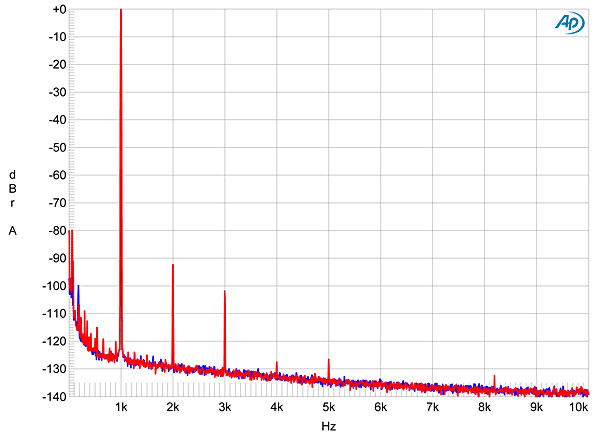| Columns Retired Columns & Blogs |
LFD Phonostage LE phono preamplifier Measurements
Sidebar 3: Measurements
I measured the LFD Phonostage LE and LE Special with Stereophile's loan sample of the Audio Precision SYS2722 system (see the January 2008 "As We See It" and www.ap.com). There were almost no measurable differences between the two units. Both had a gain of 37.4dB as used by Art Dudley, which is appropriate for moving-magnet cartridges and high-output moving-coils, and, contrary to AD's conjecture, both preserved absolute polarity; ie, were non-inverting. Linking the jumpers for high-gain operation resulted in a gain of 50.25dB, which is a little on the low side for low-output MC cartridges. Both figures are also slightly lower than specified, even after allowing for the 20 ohm output impedance of the SYS2722.
The input impedances of both models of the Phonostage LE measured 46k ohms at low and middle frequencies, dropping slightly to 40k ohms at 20kHz. The output impedance at high and middle frequencies was very low, at <2 ohms, but this rose to a still-low 150 ohms at 20Hz, presumably due to a DC-blocking output capacitor. The Phonostage LE's RIAA correction (fig.1) was not as accurate I have come to expect these days, though its channel-matching was extremely close, and the LE's equalization error (cyan and magenta traces) was almost identical to that of the LE Special (blue and red). The relative lack of midrange energy that can be seen in fig.1 will almost certainly be audible. Channel separation (not shown) was superb, any crosstalk being hidden beneath the noise floor. The fact that that each channel has its own regulated dual-rail supply will be a factor here.

Fig.1 LFD Phonostage LE Special, response with RIAA correction (left channel blue, right red); and Phono LE (left cyan, right magenta, offset by 1dB for clarity; 0.5dB/vertical div.).
Both samples of the LFD Phonostage LE were very quiet, though the LE, its left channel in particular, was quieter than the LE Special. (Connecting the LE's rear-panel grounding post to the ground terminal of the Audio Precision had no effect on the measurement.) The Special's wideband, unweighted signal/noise ratios, taken with its inputs shorted and referred to an input signal of 1kHz at 5mV, were 63.1dB left and 65.9dB right, with A-weighting increasing these figures to 85.3 and 79.8dB, respectively. The standard LE measured 83.5dB left and 75.1dB right, wideband unweighted; and 90.5dB left and 86.3dB right, A-weighted. The spectrum of the LE's noise is shown in fig.2. The downward slope of the noise floor is due to the RIAA equalization, but spectral components can be seen at 60 and 180Hz, these most likely due to low-level magnetic coupling from the transformer. I am not sure where the other small spectral spikes arise from, however.

Fig.2 LFD Phonostage LE Special, low gain, spectrum of 1kHz sinewave, DC–1kHz, at 2V into 100k ohms (left channel blue, right red; linear frequency scale).
The LE and LE Special also offered very low levels of harmonic distortion, even when used to drive low impedances. Fig.3 plots the THD+noise percentage at an input level equivalent to 1kHz at 10mV; though the right channel's figures (red and magenta traces) are higher than the left's (blue and cyan), the actual distortion above 100Hz is buried under the noise. Only at low frequencies into 600 ohms (cyan and magenta traces) does the THD+N rise, and then only slightly. The notch in these traces, by the way, is due to the very slight level of AC-supply hum being in antiphase to the distortion.

Fig.3 LFD Phonostage LE Special, low gain, distortion (%)vs frequency at 750mV into: 100k ohms (left channel blue, right red), 600 ohms (left cyan, right magenta).
Spectral analysis with a 1kHz tone at an even higher level (27mV), into 100k ohms (fig.4), showed a vanishingly low level of harmonics, with the subjectively innocuous second harmonic the highest at –107dB left and –104dB right, these respectively equivalent to 0.0004% and 0.0006%. Repeating the analysis with a 600 ohm load (fig.5) raised the second harmonic to –93dB (0.002%), and the third harmonic can now be seen at –101dB (0.0009%), but these harmonics are still inconsequential given their low level and low order. Intermodulation distortion, even into 600 ohms (not shown), was also vanishingly low, illustrating—as I mention elsewhere in this issue, in my Follow-Up on the Musical Fidelity M1 DAC, which also uses 5534-type op-amps for its output stage—that this venerable chip couples superb linearity with the ability to drive low impedances without breaking a sweat.

Fig.4 LFD Phonostage LE Special, low gain, spectrum of 50Hz sinewave, DC–1kHz, at 2V into 100k ohms (left channel blue, right red; linear frequency scale).

Fig.5 LFD Phonostage LE Special, low gain, spectrum of 50Hz sinewave, DC–1kHz, at 2V into 600 ohms (left channel blue, right red; linear frequency scale).
Finally, the LE Special's overload margins in its low-gain mode were superb, at 28dB across the audioband. The LE's margins were all around 2dB lower, which is still excellent. High-gain mode, referred to a typical MC cartridge's output of 500µV at 1kHz, increased these margins by 3–4dB!
The LFD Phonostage LE looks deceptively simple in its design, its only active devices being a single op-amp and a pair of voltage regulators in each channel. But other than the non-flat RIAA equalization, which I must assume was a deliberate design decision, given the close match both between channels and between the two samples, the measured performance of both versions was first-class.—John Atkinson
- Log in or register to post comments




































